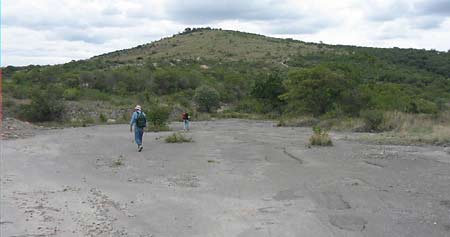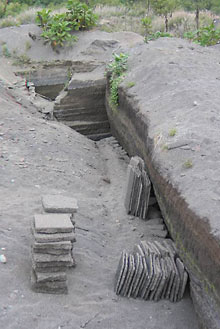UC Berkeley Press Release
 The surface outcrop of xalnene tuff, looking much like an asphalt parking lot, in which the alleged human footprints were found. Michael Waters of Texas A&M (left) and UC Berkeley graduate student Kim Knight (center) were part of the team whose dating tests threw cold water on the footprint hypothesis. (Photos by Paul Renne/Berkeley Geochronology Center) |
Alleged 40,000-year-old human footprints in Mexico much, much older than thought
BERKELEY – Alleged footprints of early Americans found in volcanic rock in Mexico are either extremely old - more than 1 million years older than other evidence of human presence in the Western Hemisphere - or not footprints at all, according to a new analysis published this week in Nature.
The study was conducted by geologists at the Berkeley Geochronology Center and the University of California, Berkeley, as part of an investigative team of geologists and anthropologists from the United States and Mexico.
 A tracery of tire marks amid indentations in the volcanic rock. Note the resemblance to shoeprints, not footprints. |
Earlier this year, researchers in England touted these "footprints" as definitive proof that humans were in the Americas much earlier than 11,000 years ago, which is the earliest firm date for human settlements after the first Americans arrived across a northern land-bridge from Asia.
These scientists, led by geologist Silvia Gonzalez of Liverpool's John Moores University, dated the volcanic rock at 40,000 years old. They hypothesized that early hunters walked across ash freshly deposited near a lake by volcanoes that are still active in the area around Puebla, Mexico. The so-called footprints, subsequently covered by more ash and inundated by lake waters, eventually turned to rock.
But Paul Renne, director of the Berkeley Geochronology Center and an adjunct professor of earth and planetary science at UC Berkeley, and his colleagues in Mexico and at Texas A&M University report in the Dec. 1 issue of Nature a new age for the rock: about 1.3 million years.
"You're really only left with two possibilities," Renne said. "One is that they are really old hominids - shockingly old - or they're not footprints."
Renne's colleagues are Michael R. Waters, director of the Center for the Study of the First Americans at Texas A&M University; Joaquin Arroyo-Cabrales and Mario Perez-Campa of the Mexican National Institute of Anthropology and History; Patricia Ochoa Castillo of the Mexican National Museum of Anthropology; and UC Berkeley graduate students Joshua M. Feinberg and Kim B. Knight. The Berkeley Geochronology Center, located a block from the UC Berkeley campus, is one of the world's preeminent anthropological dating laboratories.
Paleoanthropologist Tim White, professor of integrative biology at UC Berkeley, is familiar with the "so-called footprints" and knows Renne well, frequently collaborating with him in the dating of million-year-old sediments in an area of Ethiopia where White has excavated numerous fossils of human ancestors. He is not surprised at the new finding.
"The evidence (the British team) has provided in their arguments that these are footprints is not sufficient to convince me they are footprints," said White, who did not contribute to the new work that Renne's group is reporting in Nature. "The evidence Paul has produced by dating basically means that this argument is over, unless indisputable footprints can be found sealed within the ash."
Renne determined the new date using the argon/argon dating technique, which reliably dates rock as young as 2,000 years or as old as 4 billion years. The British-led researchers, however, relied mainly on carbon-14 dates of overlying sediments. Carbon-14 cannot reliably date materials older than about 50,000 years.
The idea for another test that, it turns out, throws more cold water on the footprint hypothesis came to Renne one morning in the shower. Many rocks retain evidence of their orientation at the moment they cool in the form of iron oxide grains magnetized in a direction parallel to the Earth's magnetic field at the time of cooling. Because the Earth's field has repeatedly flipped throughout the planet's history, it is possible to date rock based on its magnetic polarity.
Feinberg found that the rock grains in the volcanic ash had polarity opposite to the Earth's polarity today. Since the last magnetic pole reversal was 790,000 years ago, the rock must be at least that age. Because the Earth's magnetic polarity changes, on average, every 250,000 years, the argon/argon date is consistent with a time between 1.07 and 1.77 million years ago when the Earth's polarity was opposite to that of today.
Moreover, Feinberg found that each individual grain in the rock is magnetized in the same direction, meaning that the rock has not been broken up and reformed since it was deposited. This makes extremely unlikely the possibility that the original ash had been weathered into sand that early humans walked through before the sand was welded into rock again.
"Imagine two-millimeter-wide BBs cemented together where they're touching," Feinberg said. "The paleomagnetic data tell us that these things did not move around at all since they were deposited. They haven't been eroded and redeposited anywhere else. They fell while they were still hot, which raises the question of the validity of the footprints. If they were hot, why would anybody be walking on them?"
The British researchers, funded by the United Kingdom's Natural Environment Research Council, have promoted their hypothesis widely, most prominently at a July 4, 2005, presentation and press conference at the Royal Society's Summer Science Exhibition 2005 in London. The team, which includes Gonzalez as well as Professor David Huddart from John Moores University, also involves scientists from Bournemouth University, the University of Oxford and the Australian National University. They have yet to publish a peer-reviewed analysis of the footprints.
In all, the British team claims to have found 250 footprints - mostly human, but also dog, cat and cloven-hoofed animal prints - in a layer of volcanic ash deposited in a former lake bed now exposed near a reservoir outside Puebla. Its dating techniques returned a date of 40,000 years ago, in contrast to the oldest accepted human fossil from the Americas, an 11,500-year-old skull. This makes the rock "one of the most important areas in the study of early human occupation in the Americas and would support a much earlier human migration than is currently accepted," the team wrote.
One of the team members, Matthew Bennett of Bournemouth, was quoted on a Royal Society Web site as saying, "Accounting for the origin of these footprints would require a complete rethink on the timing, route and origin of the first colonization of the Americas."
 The xalnene tuff is cut into building blocks at small quarries such as this. The volcanic rock was used in building by early Mexicans long before Europeans landed in America. |
Renne, Knight, Waters and the Mexico City archeologists visited the site at the Toluquilla quarry last year while collecting rocks from another anthropological site across the reservoir. Renne noted that the black, basaltic rock is very tough and is mined in slabs for building. Pre-Columbian Mexicans also constructed buildings from the rock, which they called xalnene, meaning "fine sand" in the Nahuatl language. Today, trucks headed toward the quarry routinely drive across the xalnene tuff in which the alleged footprints are found, and the rock itself is pockmarked with many depressions in addition to the alleged footprints.
"They're scattered all over, with no more than two or three in a straight line," which would be expected if someone had walked through the ash, Renne said. If the depressions were footprints, they could not have been made by modern humans, he noted, since even in Africa, Homo sapiens did not appear until about 160,000 years ago. Given the age of the volcanic rock and lacking other evidence of early human ancestors in the Americas 1.3 million years ago, the researchers wrote in their paper, "we consider such a possibility to be extremely remote."
Many paleontologists have withheld judgment on the alleged footprints, awaiting good geological dates, Feinberg said. "With this study, we're trying to nip any misrepresentation in the bud."
The research was supported by the Center for the Study of the First Americans, the North Star Archaeological Research Program and the Berkeley Geochronology Center.
Related links:
- Mexican footprints Web site, including the British team's response to the new study by Renne and his colleagues

